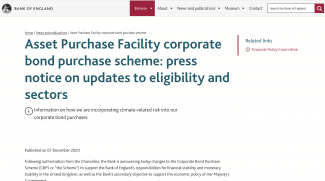Information on how we are incorporating climate-related risk into our corporate bond purchases
Published on 7 December 2020
Following authorisation from the Chancellor, the Bank is announcing today changes to the Corporate Bond Purchase Scheme (CBPS or “the Scheme”) to support the Bank of England’s responsibilities for financial stability and monetary stability in the United Kingdom, as well as the Bank’s secondary objective to support the economic policy of Her Majesty’s Government.
On 2 April 2020, the Bank announced an additional programme of corporate bond purchases, financed by central bank reserves, via the Asset Purchase Facility (APF), which would take the size of the CBPS to £20 billion. The Bank of England’s first climate-related financial disclosure, published in June, indicated that the CBPS portfolio is consistent with an average temperature rise of 3.5°C above pre-industrial levels by 2100. Given that Her Majesty’s Government is committed to holding global temperature rises well below 2°C via the Paris Agreement adopted under the United Nations Framework Convention on Climate Change, the Bank judges that changes to the Scheme are necessary to protect and enhance financial stability while supporting the delivery of the government’s carbon targets.
Climate change represents material financial risks, including not only physical risks which arise from the increased frequency and severity of climate and weather-related events, but also transition risks, resulting from the transition towards a low-carbon economy. In his remit and recommendations letter dated 11 March 2020, the Chancellor of the Exchequer recommended that the Bank’s Financial Policy Committee (FPC) should regard risks from climate change as relevant to its primary objective to protect and enhance the financial system. The Chancellor also clarified that in the context of its secondary objective to support the government’s economic policy, the Committee has a role to play in supporting the government’s Green Finance Strategy, which aims to ensure that the financial system is able to act to facilitate finance to support the delivery of the UK’s carbon targets and clean growth.
Additionally, the Financial Services Act 2012 places obligations on the FPC to have regard for risks to public funds. The FPC judges that the risks to asset valuations posed by climate change and the prospect of ‘stranded assets’ means that the Bank is directly exposed to climate risk through the CBPS. The Bank therefore considers changes to the CBPS, which is indemnified by the Treasury, necessary to exercise its fiduciary duty and to protect the taxpayer from losses.
Following review from risk management staff, the Bank is updating the eligibility criteria of corporate bonds for monetary policy operations, starting with the exclusion of those which are most exposed to climate risk.
The Bank of England currently purchases bonds from companies in 9 sectors, using a common sector classification. These sectors are Electricity; Consumer, Non-cyclical; Industrial & Transport; Communications; Consumer, Cyclical; Water; Gas; Energy; Property & Finance. As detailed in the Bank’s climate-related financial disclosure 2020, Electricity and Energy sectors are particularly exposed to the risk of stranded oil and coal assets.
The Bank therefore intends, as a first step, to screen and exclude bonds issued by those companies in the Electricity and Energy sectors with the highest exposure to oil and coal from eligibility for the CBPS. The Bank expects to publish a first update to the list of eligible securities in mid-January.
The Monetary Policy Committee (MPC) and FPC will continue to review further changes to the eligible list, including measures to reduce exposure from bonds issued by carbon-intensive companies—for whom a high proportion of revenues depend on fossil fuel extraction—from other sectors.
The Bank shall still aim to purchase a balanced portfolio of bonds across eligible issuers and sectors, but it will ensure that this portfolio is consistent with the UK’s carbon targets. The Bank will continue to make purchases such that its aggregate holdings are representative of each sector’s share—in terms of the face value of bonds outstanding—within the list of eligible bonds. However, the Bank recognises that the share of assets from carbon-intensive sectors in its corporate bond portfolio is currently not representative of these sectors’ material contribution to the UK economy, in terms of gross value added (GVA) or employment.
By 2030 the Bank will aim to maintain a portfolio of bonds consistent with temperature warming of 1.5°C above pre-industrial levels. This would bring the CBPS in line with the carbon footprint target outlined in the Bank’s report on its climate-related financial disclosure.
If the supply of eligible bonds on the private market is insufficient to maintain the size of the Scheme determined by the MPC, the Bank of England will reinvest funds into the purchase of UK sovereign government bonds (“gilts”), including sovereign green bonds, subject to availability.
The Bank will publish a separate Statement that sets out its rationale and supporting material for this change, as well as an exchange of letters between the Governor and the Chancellor, on 11 December 2020, alongside the Financial Stability Report and FPC Record.
See the original webpage here.
